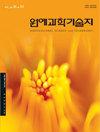Different Activities of Pectin-degrading Enzymes Affecting the Growth of Asian Pears
IF 0.8
4区 农林科学
Q3 HORTICULTURE
Korean Journal of Horticultural Science & Technology
Pub Date : 2023-10-31
DOI:10.7235/hort.20230046
引用次数: 0
Abstract
Fruit size is determined by the number and size of cells resulting from cell division and expansion, which are correlated with changes in the cell wall content. The pivotal roles of pectin-methylesterase (PME) and polygalacturonase (PG) have been well documented with regard to fruit ripening. Therefore, this study analyzed fruit growth and pectin contents for three consecutive years (from 2019 to 2021) until 180 days after full bloom (DAFB) at 15-day intervals to examine how pectin in the cell wall components affects fruit growth and development. Although there were no differences in the fruit size at harvest for these three years, the absolute fruit growth rate (AGR) peaked most rapidly in 2020, reaching the maximum fruit size earlier compared to the other two years. The pectin content of fruits in 2020, which showed the fastest growth, remained at a low level early in the growing season compared to those in the other years. The change in the pattern of the gradual increase in the PG activity with a decrease in the PME activity resulted in correspondingly different intersecting points over the three years. We found that the intersection of PME and PG activities observed in the order of 2020, 2021, and 2019 was identical to the order when the fruits reached their final weight. Interestingly, this timeline coincided with the point in time when the AGR increased rapidly over these three years. Differences in fruit volume increases, pectin contents, and pectin-degrading enzyme activities observed during fruit growth over three years suggest that the intersection of PME and PG activities is one of the key factors influencing cell expansion activation. Taken together, these results indicate that the intersection of PME and PG activities may affect the pectin content during fruit growth and development, which in turn affects the fruit growth rate in Asian pears.不同果胶降解酶活性对亚洲梨生长的影响
果实大小由细胞分裂和扩增产生的细胞数量和大小决定,而细胞数量和大小又与细胞壁含量的变化有关。果胶甲基酯酶(PME)和聚半乳糖醛酸酶(PG)在果实成熟过程中的关键作用已被广泛报道。因此,本研究连续3年(2019 - 2021),每隔15天,分析果实生长和果胶含量,直到开花后180天(DAFB),以研究细胞壁成分中的果胶对果实生长发育的影响。虽然这3年收获时果实大小没有差异,但绝对果实生长率(AGR)在2020年达到峰值最快,比其他2年更早达到最大果实大小。增长最快的2020年果实果胶含量在生长期初期较其他年份保持较低水平。PG活性逐渐升高而PME活性逐渐降低的模式变化导致了3年内相应不同的交点。我们发现,在2020年、2021年和2019年观察到的PME和PG活性的交集与果实达到最终重量时的顺序相同。有趣的是,这个时间轴与AGR在这三年中快速增长的时间点相吻合。3年果实生长过程中果实体积增大、果胶含量和果胶降解酶活性的差异表明,PME和PG活性的交叉是影响细胞扩增激活的关键因素之一。综上所述,PME和PG活性的交集可能会影响果实生长发育过程中的果胶含量,从而影响果实的生长速度。
本文章由计算机程序翻译,如有差异,请以英文原文为准。
求助全文
约1分钟内获得全文
求助全文
来源期刊
CiteScore
2.00
自引率
0.00%
发文量
0
审稿时长
1 months
期刊介绍:
Horticultural Science and Technology (abbr. Hortic. Sci. Technol., herein ‘HST’; ISSN, 1226-8763), one of the two official journals of the Korean Society for Horticultural Science (KSHS), was launched in 1998 to provides scientific and professional publication on technology and sciences of horticultural area. As an international journal, HST is published in English and Korean, bimonthly on the last day of even number months, and indexed in ‘SCIE’, ‘SCOPUS’ and ‘CABI’. The HST is devoted for the publication of technical and academic papers and review articles on such arears as cultivation physiology, protected horticulture, postharvest technology, genetics and breeding, tissue culture and biotechnology, and other related to vegetables, fruit, ornamental, and herbal plants.

 求助内容:
求助内容: 应助结果提醒方式:
应助结果提醒方式:


